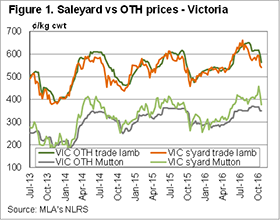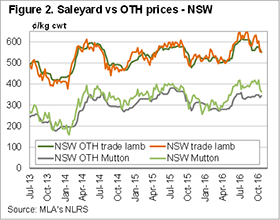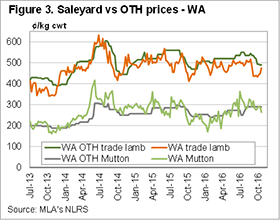By: Angus Brown
Source: NLRS

With lamb prices on the slide in saleyards, many may be exploring their options in the over the hooks market. It timely to take a look at the historical relationship between saleyard and over the hooks prices, as a guide to where the best value might be found during the spring lamb and sheep flush.
It makes sense that over the hooks lamb prices and saleyard lamb prices move together. If lambs become cheap in saleyards, processors will be able to lower rates and still attract lambs and vice versa.
Each week Meat and Livestock Australia (MLA) survey processors on their over the hooks prices for a range of lamb and sheep categories. MLA publish a range of prices,  and an average, the over the hooks prices used in this analysis are the average price of trade lambs reported by MLA, the ones you see in Meat and Livestock Weekly.
and an average, the over the hooks prices used in this analysis are the average price of trade lambs reported by MLA, the ones you see in Meat and Livestock Weekly.
Figure 1 shows how trade lamb prices have fared in saleyards and over the hooks markets over the last three years. In the lamb market the over the hooks prices tend to lag the saleyard prices, especially on the way down. This may be a little misleading as over the hooks values tend to follow a bit more quickly, but they are only reported weekly.
It should be remembered that saleyard indicators are weighted average of all lamb pri ces. As such there will be lambs which are price higher, and lower in saleyards depending on location and quality. Figure 1 does shows that ‘average’ lambs are rarely more expensive in saleyards than over the hooks.
ces. As such there will be lambs which are price higher, and lower in saleyards depending on location and quality. Figure 1 does shows that ‘average’ lambs are rarely more expensive in saleyards than over the hooks.
For sheep, the story is a bit different, with saleyards generally holding a premium to over the hooks values. For most of the last six month mutton in saleyards has been priced around 50¢ higher than the over the hooks equivalent.
In NSW (figure 2) the story for mutton has been similar, but the saleyard lamb indicator has spent a lot more time at a premium to the over the hooks value, up to 50¢ in recent months.
Over in the West, the saleyard lamb indicator and the over the hooks prices seem to have a weaker relationship (figure 3), especially for short term spikes and declines, which are more common than on the east coast. With sheep, WA saleyard mutton values tend to fluctuate around the over the hooks values.
What does this mean?
The fact that MLA’s over the hooks lamb quotes follow saleyards closely should give some solace to those worried that their choice of marketing channel might be costing them. In reality there is likely to be more difference in selling costs and freight between the two options than there is in price. It is still prudent to keep an eye on both prices, and with MLA’s over the hooks reports released every Monday, it is easier to look up the report than ring all the processors.
For sheep there is often a premium offered in saleyards, and it definitely pays to compare the saleyard rates with those offered over the hooks, and do the sums on selling costs. There is often a good chance the saleyards might pay you more.
Key points
- Saleyard and over the hooks prices tend to track together in lamb markets, and less so in sheep markets.
- In WA the relationships are less reliable, with saleyard lambs usually at a discount to over the hooks.
- Those looking to sell lambs should look at saleyard and over the hooks prices, while, sums should always be done on selling mutton.
CLICK HERE for original article